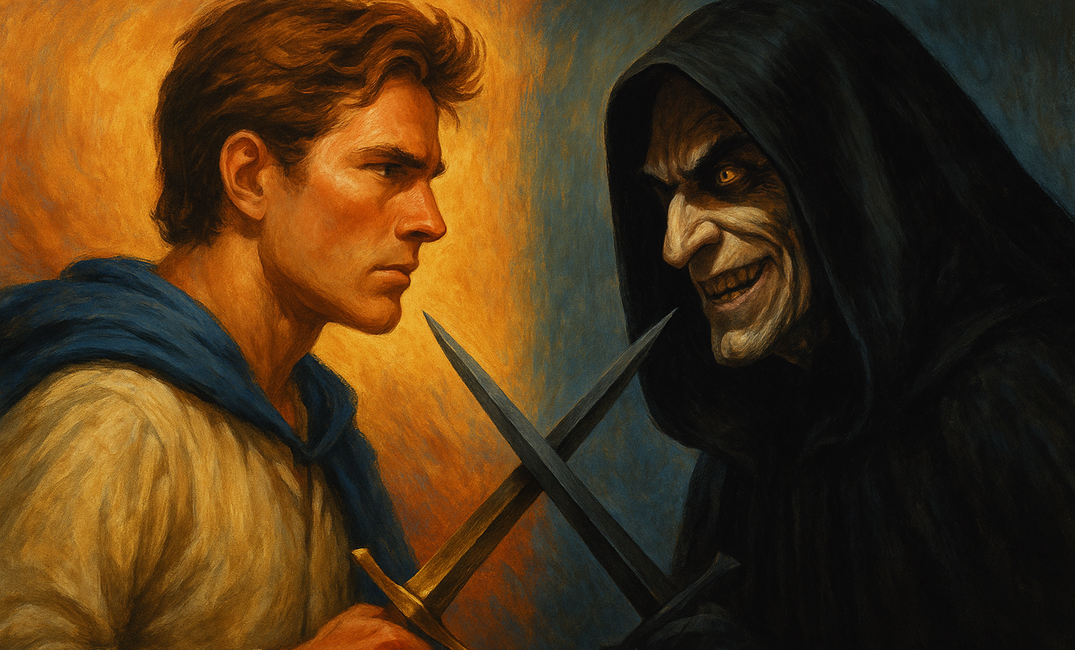Table of Contents
Look, I love a great hero. Seriously—I’m all for noble quests and selfless courage and characters who step bravely into the spotlight. But I’m also here to drop a truth bomb: your protagonist might not actually be the character driving your story.
Wait—hear me out.
We’re conditioned to see protagonists as our heroes, our guides, our narrative North Stars. They’re the ones whose struggles we track page after page, film after film. Yet sometimes—often, actually—the true heartbeat of your story isn’t the protagonist’s noble cause. Nope. It’s the antagonist’s beautifully twisted goal. Because without the villain or antagonist pushing, provoking, and pulling strings behind the curtain, your protagonist wouldn’t have much to do besides sipping tea and pondering life’s existential dread (which, to be fair, does describe about half of classic Russian literature).
Want help fleshing out your characters and their opposing forces? Try Sudowrite to sharpen both protagonist and antagonist arcs.
Protagonist vs. Antagonist: The Eternal Tug-of-War
Let’s start simple: a protagonist is your main character—the one readers typically identify with. An antagonist is anyone (or anything) standing directly against the protagonist’s goal. Easy enough, right?
Well, sort of.
But what happens when your antagonist is the one actively shaping the plot, forcing your protagonist to respond, adapt, and change? Spoiler alert: that’s most compelling stories. Without Voldemort’s dark ambitions, Harry Potter is just another angsty teen battling schoolwork and crushes. Without Thanos and his twisted-yet-compelling reasoning, the Avengers spend their time quipping at each other, but without that universe-threatening urgency.
A great antagonist doesn’t just block a protagonist’s path; they actively define it. It’s not only a rivalry—it’s a twisted partnership that gives both meaning.
Protagonist Goals: Why Should We Care?
Look, your protagonist needs a goal—but it needs to be compelling enough for readers to root for. Frodo’s goal isn’t just "carry the Ring"; it's a desperate bid to save his idyllic Shire from corruption. Katniss isn’t simply "trying to survive"; she wants to defy and dismantle an oppressive system.
But a protagonist's goal is meaningless without an antagonist’s equally compelling motivation pushing against it. If the antagonist is weak, vague, or nonsensical, your story fizzles faster than the final season of Game of Thrones.
Antagonist Motivation: Make It Real, Make It Compelling
Remember: No villain sees themselves as the villain. To them, their cause is righteous, justified, necessary—even moral. Thanos genuinely believes he’s saving the universe from collapse by wiping out half its population. Killmonger in Black Panther isn’t seeking destruction—he's driven by a deeply personal need to rectify historical injustice. These antagonists resonate because their motivations feel disturbingly rational, even relatable.
Great antagonists aren’t just obstacles; they embody believable alternative worldviews that challenge your protagonist’s beliefs, values, and choices. They force characters—and readers—to grapple with unsettling questions. And we secretly love them for it.
Mirror Images: When Antagonists Reflect Your Hero’s Dark Side
One fascinating way to drive narrative depth is through mirrored flaws. Think Batman and the Joker: both are shaped by trauma. Both see Gotham’s brokenness. But Batman believes order and justice can prevail, whereas the Joker’s nihilistic philosophy embraces chaos. Joker doesn’t just oppose Batman; he reflects what Batman might become if his grip slips.
Similarly, Sherlock and Moriarty. Both brilliant, arrogant, detached—two sides of a single obsessive coin. Moriarty’s existence pushes Sherlock deeper into moral gray areas, revealing uncomfortable truths about himself.
Mirrored antagonists transform conflicts from simple fights to profound philosophical battles.
Stuck on your villain’s backstory? Sudowrite’s brainstorming tools can help you build a layered, believable antagonist.
Antiheroes and Antivillains: Playing with Moral Ambiguity
Let’s muddy things further (because neat morality is overrated, anyway). Sometimes protagonists aren’t heroes, and antagonists aren’t villains. Enter antiheroes and antivillains:
- Antihero: Protagonists lacking heroic traits. They’re flawed, often morally dubious, yet we root for them anyway. Walter White from Breaking Bad or Lisbeth Salander from The Girl with the Dragon Tattoo.
- Antivillain: Antagonists with noble or sympathetic motives. Killmonger from Black Panther, Snape from Harry Potter, or Roy Batty in Blade Runner. They challenge our moral comfort zones, blurring lines between right and wrong.
Antiheroes and antivillains ask us why we root for anyone in the first place. Are our heroes heroic because they do good, or simply because they're the ones telling the story?
For help crafting distinctive character motivations and internal conflicts, explore Characters That Feel Real: The Art of Crafting Memorable Protagonists.
Internal Antagonists: When the Conflict Is Personal
Who says the antagonist needs to be external? Some of literature’s best antagonists lurk within the protagonist’s own psyche. Consider Holden Caulfield in The Catcher in the Rye: his biggest enemy is his internal despair, cynicism, and unwillingness to engage authentically with the world. In Dostoevsky’s Crime and Punishment, Raskolnikov’s inner torment and guilt drive the entire narrative, more powerfully than any external detective ever could.
Internal antagonists turn your story into a compelling psychological battle. Can your protagonist overcome their own flaws and demons?
The Unexpected Twist: When Roles Switch Mid-Story
Now, let’s have fun. What happens when protagonists and antagonists switch places?
Neil Gaiman’s American Gods plays brilliantly here: Shadow initially seems to be a hero fighting a clear antagonist. As the story evolves, roles blur and shift, leaving readers questioning who’s truly driving the narrative. The line between protagonist and antagonist becomes fluid, forcing readers to constantly reassess loyalties.
Similarly, Gone Girl by Gillian Flynn shatters expectations mid-novel, flipping protagonist and antagonist so dramatically that readers literally gasp. This technique keeps readers fascinated, unsettled, and completely unable to look away.
For more on how characters grow and change in response to these dynamics, check out How to Write a Compelling Character Arc.
Conflict, Transformation, and Growth
Remember this: your antagonist shapes your protagonist’s arc. Without Voldemort, Harry wouldn’t mature from a scared boy into a courageous leader. Without Hannibal Lecter, Clarice Starling wouldn’t confront her inner demons. The antagonist, in many ways, is the catalyst of character growth—making their presence not only important but absolutely essential.
Don’t reduce antagonists to cardboard obstacles. They deserve complex backstories, real motivations, understandable reasons—even sympathy. The richer your antagonist, the more your protagonist must evolve, deepening emotional stakes and reader investment.
Crafting foils or mirrored rivals? Try the Character Name Generator for just the right names and vibes.
How to Nail Your Antagonist: Practical Tips
- Make Them Human (or at Least Understandable)
We don’t need to like your antagonist, but we must understand why they do what they do. Understanding creates conflict that resonates. - Give Them a Clear, Relatable Motivation
Every villain needs a believable "why." Even a dragon guarding gold needs a reason beyond greed—maybe loneliness, fear, or pride. - Tie Them Directly to Your Protagonist’s Growth
They must directly force your protagonist to confront their flaws, fears, or desires. Without this dynamic, their conflict feels superficial. - Let Them Win…Sometimes
Occasional victories or near-victories increase tension. We need to believe they’re a genuine threat. - Remember, Villains are Heroes of Their Own Stories
Let your antagonist’s narrative make sense independently. If you can rewrite your story from their POV and make them sound like the hero—you've nailed it.
Final Thoughts: It’s a Beautifully Messy Dance
The protagonist-antagonist relationship is messy, complicated, and full of contradictions—just like real life. At its best, it should force your readers into uncomfortable moral territory, blur lines between right and wrong, and leave them questioning their own allegiances.
Because in the end, stories aren’t just about good versus evil. They’re about the gray spaces in between—the spaces we live, love, fear, and sometimes hate to admit are actually home.
Protagonist or antagonist—whoever drives your story, ensure they’re complex enough to stick in readers’ minds long after they’ve closed the book (or turned off the screen). Your readers deserve characters who challenge, provoke, and transform—characters who remind us exactly why we bother to read in the first place.
Need help rewriting scenes from your villain’s point of view? Sudowrite’s Describe or Rewrite tools can help.

Get to your final draft, faster
Our Write feature can generate your next 100-500 words in your style, helping you finish drafts in record time. Choose from multiple options. Edit as you like.
Polish without losing your voice
Using Rewrite, you can refine your prose and still be your unique self, by choosing from multiple AI-suggested revisions designed to capture your voice.
Paint descriptions with more pop
Describe helps you make sure readers feel like they’re really there, proposing new ideas for enriching scenes — whenever some are needed.
Build out scenes with ease
With Expand, you can smoothly and quickly build out scenes, slow pacing, and add immersive detail, all without breaking your flow.
Effortlessly outline your story
Story Bible gets you from idea to outline in a flash, helping you structure plot, character arcs, and themes — step-by-step.
Revise faster with instant feedback
Sudowrite’s Feedback tool delivers AI-powered suggestions for improvement on demand, as often as you need, and without complaint. Make room, beta readers.
Banish writers block – forever!
Creative prompts from Brainstorm keep you flowing, and the tool learns more about how you think, the more you use it. Bye bye, blinking cursor.



